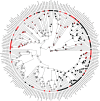Male-like female morphs in hummingbirds: the evolution of a widespread sex-limited plumage polymorphism
- PMID: 33622128
- PMCID: PMC7935062
- DOI: 10.1098/rspb.2020.3004
Male-like female morphs in hummingbirds: the evolution of a widespread sex-limited plumage polymorphism
Abstract
Differences in the way males and females look or behave are common in animals. However, discrete variation within sexes (sex-limited polymorphism) also occurs in several vertebrate and invertebrate lineages. In birds, female-limited polymorphism (FLP) in which some females resemble males in coloration is most prominent in hummingbirds, a group known for its morphological and behavioural sexual dimorphism. Yet, it remains unclear whether this intrasexual colour variation in hummingbirds arises through direct selection on females, or indirectly as a non-adaptive byproduct resulting from selection on males. Here, we analysed specimens from more than 300 hummingbird species to determine the extent, evolutionary history and function of FLP. We found that FLP evolved independently in every major clade and occurs in nearly 25% of hummingbird species. Using phylogenetically informed analyses, we rejected non-adaptive hypotheses that FLP is the result of indirect selection or pleiotropy across species. Instead, FLP is associated with ecology, migratory status, and marginally with social dominance, suggesting a socioecological benefit to females. Ultimately, we show that FLP is not only widespread in hummingbirds and likely adaptive, but may also be useful for understanding the evolution of female ornamentation in systems under strong sexual selection.
Keywords: hummingbirds; plumage; sex-limited polymorphism; social selection; social signalling.
Figures


Similar articles
-
Male-like ornamentation in female hummingbirds results from social harassment rather than sexual selection.Curr Biol. 2021 Oct 11;31(19):4381-4387.e6. doi: 10.1016/j.cub.2021.07.043. Epub 2021 Aug 26. Curr Biol. 2021. PMID: 34450085
-
Progress on the formation mechanism of sexual dimorphism plumage color in birds.Yi Chuan. 2022 Jun 20;44(6):491-500. doi: 10.16288/j.yczz.22-004. Yi Chuan. 2022. PMID: 35729097 Review.
-
The effects of life history and sexual selection on male and female plumage colouration.Nature. 2015 Nov 19;527(7578):367-70. doi: 10.1038/nature15509. Epub 2015 Nov 4. Nature. 2015. PMID: 26536112
-
Colour polymorphism in birds: causes and functions.J Evol Biol. 2003 Jul;16(4):635-46. doi: 10.1046/j.1420-9101.2003.00569.x. J Evol Biol. 2003. PMID: 14632227
-
The evolution, maintenance and adaptive function of genetic colour polymorphism in birds.Biol Rev Camb Philos Soc. 2004 Nov;79(4):815-48. doi: 10.1017/s1464793104006487. Biol Rev Camb Philos Soc. 2004. PMID: 15682872 Review.
Cited by
-
Intersexual social dominance mimicry drives female hummingbird polymorphism.Proc Biol Sci. 2022 Sep 14;289(1982):20220332. doi: 10.1098/rspb.2022.0332. Epub 2022 Sep 7. Proc Biol Sci. 2022. PMID: 36069013 Free PMC article.
-
Multivariate study of lice (Insecta: Psocodea: Phthiraptera) assemblages hosted by hummingbirds (Aves: Trochilidae).Parasitology. 2024 Feb;151(2):191-199. doi: 10.1017/S0031182023001294. Epub 2023 Dec 20. Parasitology. 2024. PMID: 38116659 Free PMC article.
-
The evolution of sexually dimorphic traits in ecological gradients: an interplay between natural and sexual selection in hummingbirds.Proc Biol Sci. 2022 Dec 21;289(1989):20221783. doi: 10.1098/rspb.2022.1783. Epub 2022 Dec 14. Proc Biol Sci. 2022. PMID: 36515116 Free PMC article.
-
A shared gene but distinct dynamics regulate mimicry polymorphisms in closely related species.bioRxiv [Preprint]. 2025 Mar 3:2025.03.03.641230. doi: 10.1101/2025.03.03.641230. bioRxiv. 2025. PMID: 40093043 Free PMC article. Preprint.
-
The evolutionary history and mechanistic basis of female ornamentation in a tropical songbird.Evolution. 2022 Aug;76(8):1720-1736. doi: 10.1111/evo.14545. Epub 2022 Jul 7. Evolution. 2022. PMID: 35748580 Free PMC article.
References
-
- Andersson M. 1994. Sexual selection. Princeton, NJ: Princeton University Press.
-
- Darwin C. 1871. The descent of man, and selection in relation to sex. London: John Murray (10.1038/011305a0) - DOI
-
- Parker GA, Simons LW. 1996. Parental investment and the control of sexual selection: predicting the direction of sexual competition. Proc. R. Soc. Lond. B 263, 315-321. (10.1098/rspb.1996.0048) - DOI
-
- Trivers RL. 1972. Parental investment and sexual selection. In Sexual selection and the descent of man: the Darwinian pivot (ed. B Campbell), pp. 1871–1971. Chicago, IL: Aldine.
Publication types
MeSH terms
Associated data
LinkOut - more resources
Full Text Sources
Other Literature Sources

